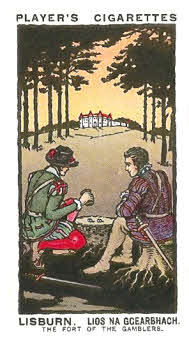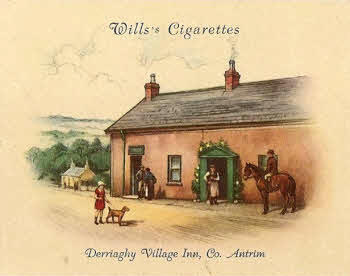
Cigarette, cleric, characters and cards
THE DIGGER

Lisburn. “Lios na gcearbhach - the Fort of the Gamblers.”
Trading cigarette cards was once an activity enjoyed by schoolboys of every age both in and out of the school playground. There would always be one or two sought after cards to complete the collection, often enhanced by an album, specially designed by a cigarette manufacturer and sold for a few pence. A vast range of subject matter was displayed on the cigarette cards, ranging from buildings, sports personalities, flowers, wildlife, boats, trains, royalty and heroes. Many years later some of these cards are still being exchanged and are considered very collectable to those who cannot get enough nostalgia.
I have two cigarette cards based on a “local” theme. In the late 1920’s John Player & Sons brought out a series of 25 cards under the title “Irish Place Names.” Amongst the local places names, including Armagh, Belfast, Derry, Downpatrick and Enniskillen was card number 20 - Lisburn. “Lios na gcearbhach - the Fort of the Gamblers.”
The rear of the card gives a brief explanation as to the origins of the town’s name and had been taken from a pamphlet published in 1691.
“We marched towards Lisburn , one of the prettiest towns in the North of Ireland. The Irish name is Lisnegarvah, which they tell me signifies “gamester’s mount,” for a little to the north-east of the town there is a mount moated about and another to the west, These were formerly surrounded with a great wood, and thither resorted all the Irish outlaws to play at cards and dice.”
The other card was a later one issued in 1939 by W.D. & H.O. Wills and was number 11 in a second series of 40 cards depicting old Inn’s throughout Ireland and Britain. Derriaghy Village Inn took its place amongst The Boot Inn in Ballymun, County Dublin, Ye Olde Trip to Jerusalem in Nottingham, The Eagle in Cambridge and The Kingshouse in Argyll. The Boot Inn, Ballymena “was often the haunt of Collier the robber,” a notorious highwayman who used to hold up coaches on the main Dublin - Drogheda road.

The inn at Derriaghy
Wills describes the inn at Derriaghy and briefly mentions some of the village’s history - “The rather plain exterior of this inn gives little indication that it is actually one of Ireland’s oldest licensed houses, dating back 250 years. The spacious old-fashioned kitchen had a high ceiling of old, varnished wood, with windows clasped in walls a foot thick. Over a century ago Daniel O’Connell stopped at Derriaghy Inn with ten steaming horses. The famous Irish statesman was on his way to Belfast, and the glasses which he used on that occasion were treasured for many years afterwards, just as he left them. Near the inn is an historic postman’s shelter which has served generations of local postmen. Derriaghy itself is a village of quaint white cottages, graceful trees and narrow byways. The name is derived from the Gaelic “Doire-Achadh,” meaning “Oak wood of the fields.”
The Reverend Robert Martin Hilliard was a curate assistant at Christ Church, Derriaghy during the years 1931 to 1933. The Very Reverend Barr makes reference to this colourful character in his 2006 publication titled “Derriaghy - a short history of the Parish.” He was born on the 7th April 1904 in Killarney where his father, also called Robert Martin, was a leather merchant. The Hilliard family were considered to be well-off and they employed the services of two domestic servants in the early 20th century. The Rev Hilliard had attended Trinity College and he was stated to be sympathetic to the Republican cause. He was expelled from Trinity prior to taking his degree for his involvement in the Irish civil war. Whilst at Trinity college he was a keen athlete and boxer which culminated in him representing Ireland in the bantamweight class at the Olympic Games in Paris in 1924 where he was defeated in the second round. John Corcoran had interviewed the Rev. Hilliard’s daughter for his 2005 publication about the life of the Rev. Hilliard. Deirdre, his daughter, recalled to the author that she could remember her father being “a very loving father, a shoulder to ride on, a rescuer of small girls from the usual scrapes, smelling of tobacco and tweed…” It would now be considered unimaginable that a man of such athletic ability would have smoked and indeed there is nothing to suggest that he did, but may have merely been in the company of others who did. However, one of his parishioners at Derriaghy would put that theory to the test. Some time ago I heard the story of the Rev. Hilliard making his way either from his residence at Knocknadona or Derriaghy Parish Church on his bicycle through the Ballymacash area to the Sunday School where he gave instruction. The corners at Ballymacash were a well known gathering spot for groups of local lads and those men who were unemployed due to a scarcity of work, passing the time and amusing themselves. On this occasion the minister would encounter Bryson Close, another colourful character who was regularly seen in the Ballymacash area.
“Good morning Mr. Close.”
“Good morning Reverend Hilliard.” The Reverend Hilliard politely enquired into Bryson’s well-being.
“Your reverence, your reverence, there’s a man dying.”
“A man dying? Tell me who is it Mr. Close?”
“Me your reverence, dying for a smoke……. and I haven’t a fag!”
The Reverend Hilliard gave him “tuppence” for a packet of Woodbine. He was a popular figure amongst the youth in the area. I was told by one man that he was considered to be a “real gentleman” and he would have given you a lit on the bar of his bicycle at any time even though his upbringing, experiences and background were in stark contrast to the likes of Bryson Close.
Bryson, the son of a labourer and latterly a lime kiln worker, had been born on 2nd July 1892 to James and Jemima Close in Matchett Street, off Tennent Street in the Shankill area of Belfast. The family had links to the Magheragall area. Jemima was from the Whitemountain area. They were married in Lisburn Cathedral in August 1874 and subsequent birth records of their older children show that the family had been in the Knocknadona area of Lisburn. The family appear to relocate to the Shankill area of Belfast and during their stay there the family were associated with St. Matthew’s Parish Church adjacent to Shankill graveyard. There are three plaques mounted on the pulpit at St. Matthews listing 114 men who lost their lives in The Great War. The memorial makes reference to the fact that some 800 men from the Parish went to serve in The Great War. One of the names recorded there is that of W.J. Close. This is believed to be William James Close born in 1883, a brother of Bryson Close. The Lisburn Herald dated 13th May 1916 published a photograph of William Close, a soldier with the Royal Inniskilling Fusiliers and announced to readers that he had been killed in action. The parish magazine of St. Matthew's dated July 1916 makes reference to the fact that Private William James Close of 17 Bracken Street had been killed in action. !7 Bracken Street was the home of James Hill and his wife Isabella. She was a sister of William Close. The information is confirmed through the research of Pat Geary on the World War One archive on Friends’ School Website. Private William Close, 14506, born in the Shankill, living in Lisburn, had been a member of the U.V.F. and had enlisted at Finner Camp, County Donegal. He was killed in action on the Somme on the 8th May 1916 and was buried in Authuile Military Cemetery, France. At the time of his death his mother Jemima was living at Ballymacash, Lisburn, where she passed away almost seven years later. Members of the Close family are buried in Magheragall Parish church.
The Reverend Hilliard later resigned from the ministry and went to London where he became involved in one of his former occupations – journalism. He also became a member of the Communist Party. In December 1936 he went to Spain and became a member of the International Brigade. He was to lose his life during the Spanish Civil War. The Lisburn Standard dated Friday 2nd April 1937 informed readers of his death. “Former Derriaghy Curate. Killed while fighting for Spanish Government.”
Also, in April 1937 Bryson Close, a member of Ballymacash Darts Team, received a medal when the team were runners-up in the Lisburn darts league. He and other members of the team would no longer be encountering Robert Hilliard at Ballymacash corners. Unfortunately the medal was lost several decades ago in the Culcavey area. It would be fantastic to reunite this item with the person who misplaced it all those years ago.
Robert Hilliard was immortalized in a song titled “Viva La Quince Brigada” by Christy Moore.
“Bob Hilliard was a Church of Ireland Pastor
From Killarney across the Pyrenees he came…..”
A chalice, paten and cruet were purchased in his memory by Derriaghy Parish Church, through a former friend, Joseph Boyd who had also been a member of the International Brigade.
Thanks to the Reverend Canon Gregory Dunstan, St. Matthew's Church of Ireland, Belfast for his assistance.
Further information on the Rev. Hilliard can be found in the following publications:
- Derriaghy – a short history of the Parish by WNC Barr
- Rev. Robert Martin Hilliard by John Corcoran
- The World War 1 database can be found online at www.friendsschoollisburn.org.uk/ww1
The Digger can be contacted by email diggerarticle@hotmail.com or at The Ulster Star.
14/03/2012
